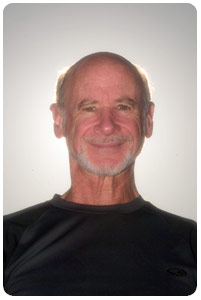|
 After more than thirty years of researching and developing highly successful therapies for spinal impairments, I sustained a traumatic spinal injury, resulting in my own immobilization. My third cervical disc on the right side was herniated and my sixth cervical disc was herniated on the left side. I had acute neck, arm, and hand pain with concomitant pins-and-needles sensations and numbness. A frightening episode occurred when I was driving my car. Suddenly, my fingers turned blue, cramped and painfully stuck together. I could not hold the steering wheel and had to pull to the side of the road using my knees to steer. After more than thirty years of researching and developing highly successful therapies for spinal impairments, I sustained a traumatic spinal injury, resulting in my own immobilization. My third cervical disc on the right side was herniated and my sixth cervical disc was herniated on the left side. I had acute neck, arm, and hand pain with concomitant pins-and-needles sensations and numbness. A frightening episode occurred when I was driving my car. Suddenly, my fingers turned blue, cramped and painfully stuck together. I could not hold the steering wheel and had to pull to the side of the road using my knees to steer.
I had also sustained a compression fracture of my twelfth thoracic vertebra, which is attached to the diaphragm muscle. Breathing became difficult, and resulted in lung congestion. Coughing was excruciating; and laughing was no laughing matter! Additionally, I sustained five protruding lumbar discs causing spinal nerve pressure on all lumbar nerves. Because of this combination of injuries, I had to crawl to the bathroom and had great difficulty raising myself to the toilet. Exerting abdominal pressure to affect a bowel movement was excruciating and very humbling.
Before my injury, I was a specialist treating spinal impairments. Afterward, I became a patient in need of spinal treatment and rehabilitation. Three years into my treatment and recovery period, my car was broadsided at a stop sign by a large pick-up truck making an illegal U-turn. That resulted in a worsening of my disc protrusions. Two years later, as a passenger, my car was rear-ended in a seven-car highway accident caused by a tractor-trailer truck's brake failure.
Each additional injury was a huge setback for my traumatized spine. However, as a doctor, I had treated even worse cases than mine and had experienced success in advising my patients' recoveries.
 By using conventional methods and gentle Spinal Mobilization Techniques that addressed the range of motion between each individual vertebra and disc in the spine, step by step progress was made in my case, as it also had been for my patients. As a doctor, specializing in spinal problems, and as a patient, personally experiencing multiple spinal problems and receiving these state-of-the-art therapies, I know how successful this approach can be. By using conventional methods and gentle Spinal Mobilization Techniques that addressed the range of motion between each individual vertebra and disc in the spine, step by step progress was made in my case, as it also had been for my patients. As a doctor, specializing in spinal problems, and as a patient, personally experiencing multiple spinal problems and receiving these state-of-the-art therapies, I know how successful this approach can be.
Although highly effective, this therapy is rarely used. It takes time to learn and time to administer. In today's third-party insurance parameters of coverage, a doctor is only allowed a limited of payment for a covered office visit. Chiropractors are paid for spinal manipulation, which covers, primarily, spinal adjustments. Other helpful modalities such as ultrasound, heat and cold packs and TENS therapies are sometimes covered; however the "time factor" to administer Spinal Mobilization Therapy is rarely covered.
If a doctor spends ten minutes for spinal adjustments or thirty minutes for spinal mobilization therapy, the insurance payment is the same. The expense of running a cost-effective practice does not permit this enhanced spinal method to be practically utilized. This is why, in my private practice, I have not accepted third-party insurance parameters. I had made a decision to provide the best possible care for my patients, regardless of what an insurance company covered, based on the needs of my patients, not on the bottom line profits of an insurance company. The proof of my results was evidenced by a waiting list of patients seeking effective relief.
As a doctor, I knew what could be achieved utilizing SMT - Spinal Mobilization Therapy. As a patient with pain and severe limitation of motion, I desperately sought the same treatment that I had rendered to thousands, for myself. Chiropractors, orthopedic surgeons, and neurologists were neither trained nor aware of these Spinal Mobilization Therapies. This applied to physical therapists as well. They are often limited to rendering care based only on the prescription of a medical doctor. My need to receive SMT necessitated my teaching these techniques to others so that I, as a patient could benefit from the treatment.
In my practice, I found that the best results for my patients were attained with a combination of Spinal Mobilization Techniques and spinal adjustments. (Home exercise, stretching, and lifestyle accommodations are also important.) During my recovery phase, I found that general massage therapy followed by chiropractic spinal adjustments were very helpful. However, since I've trained other therapists in Spinal Mobilization Therapy techniques and have received their treatments, often followed by a chiropractic visit, the benefits to me have proven tenfold.
Questions about Spinal Mobilization Therapy?
Click here to contact Dr. Sage for more information or to schedule a consultation.
Interested in the Spinal Mobilization Therapy workshop?
Click here to schedule a workshop for you and/or your team.
Learn more about Spinal Mobilization Therapy:
- What is Spinal Mobilization Therapy? How does it work?
- Candidates for Spinal Mobilization Therapy
- How to minimize getting shorter as you get older (Anti-Aging)
- Who should learn Spinal Mobilization Techniques?
- Health benefits for therapists practicing Spinal Mobilization techniques |


 After more than thirty years of researching and developing highly successful therapies for spinal impairments, I sustained a traumatic spinal injury, resulting in my own immobilization. My third cervical disc on the right side was herniated and my sixth cervical disc was herniated on the left side. I had acute neck, arm, and hand pain with concomitant pins-and-needles sensations and numbness. A frightening episode occurred when I was driving my car. Suddenly, my fingers turned blue, cramped and painfully stuck together. I could not hold the steering wheel and had to pull to the side of the road using my knees to steer.
After more than thirty years of researching and developing highly successful therapies for spinal impairments, I sustained a traumatic spinal injury, resulting in my own immobilization. My third cervical disc on the right side was herniated and my sixth cervical disc was herniated on the left side. I had acute neck, arm, and hand pain with concomitant pins-and-needles sensations and numbness. A frightening episode occurred when I was driving my car. Suddenly, my fingers turned blue, cramped and painfully stuck together. I could not hold the steering wheel and had to pull to the side of the road using my knees to steer.
 By using conventional methods and gentle Spinal Mobilization Techniques that addressed the range of motion between each individual vertebra and disc in the spine, step by step progress was made in my case, as it also had been for my patients. As a doctor, specializing in spinal problems, and as a patient, personally experiencing multiple spinal problems and receiving these state-of-the-art therapies, I know how successful this approach can be.
By using conventional methods and gentle Spinal Mobilization Techniques that addressed the range of motion between each individual vertebra and disc in the spine, step by step progress was made in my case, as it also had been for my patients. As a doctor, specializing in spinal problems, and as a patient, personally experiencing multiple spinal problems and receiving these state-of-the-art therapies, I know how successful this approach can be.